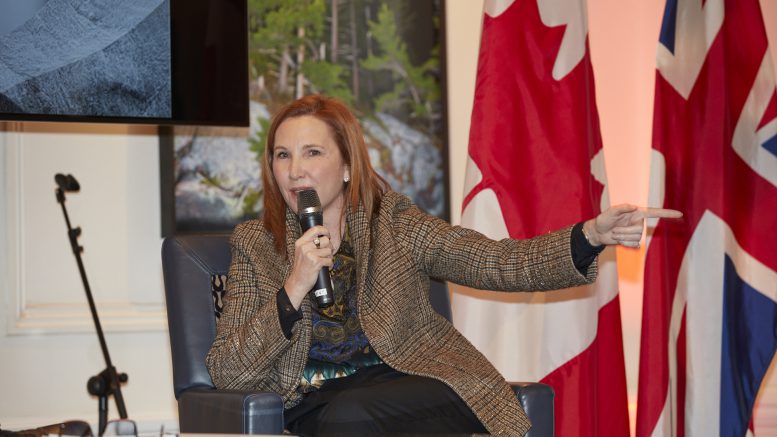The post-pandemic period represents “the best diamond market in the better part of a decade,” Lucara Diamond (TSX: LUC) president and CEO Eira Thomas told delegates at The Northern Miner’s recent Canadian Mining Symposium in London, U.K.
In an interview with The Northern Miner podcast host Adrian Pocobelli, Thomas explained the rationale of investing in a space that gives exposure to both mined commodities and consumer-marketed products.
“Demand for luxury products and diamonds has never been better,” Thomas said. “If you have an outlook that the world is going to continue to grow, albeit even now at a slower pace, then you have a positive view on the commodity.”
Lucara operates one of the highest-margin diamond mines in the world — Karowe, in Botswana, where an average of 300,000 carats are produced per year. In guidance released on Nov. 28, the company said it expects to generate between US$200 to US$230 million next year, thanks in part to the firm’s innovative sales channels.
“It’s a challenging commodity — every diamond is unique, and they all have unique price points,” she said. “How do you take that production and sell it regularly for repeatable income?”
Previously, Thomas noted, diamond sellers solved that problem by building up inventory into different ‘buckets’ based on categories including size, colour, and shape. “We would force our customers to buy an entire bucket — if you only wanted ten stones, too bad, you’d have to take all 32,” she said.
In 2020, Lucara introduced a digital twist to traditional diamond marketplaces with Clara, its 100%-owned web sales platform for rough stones. Buyers can submit queries to the Clara store requesting specific stone characteristics, and an algorithm matches available rough diamond inventory in quantities down to a single stone.
Thomas noted that having a digital market helps buyers achieve better margins by avoiding unnecessary travel costs and bucket-style pricing.
“We have technology today to make this much easier,” she said. “People can place orders without leaving their office. Normally they’d have to get on a plane and come to Botswana.”
Vote of confidence
While Thomas predicts the Clara platform will start delivering cash flow in 2023, smaller stones represent a minority of her company’s sales (only diamonds between 1 and 10 carats are sold through Clara). Instead, the Karowe mine is famous for its abundance of large, high-value diamonds greater than 10.8 carats that generate about 70% of Lucara’s annual revenue.
On Nov. 16, Lucara announced a 10-year extension of a sales agreement with HB Group, a Belgian-based diamond manufacturer. Under the agreement, Lucara’s 10.8+ carat diamonds are sold at the estimated polished outcome determined through scanning and planning technology. Final payments are based on actual sale prices minus costs and fees.
“All of our large diamonds are now being manufactured and sold as polished diamonds,” said Thomas, “so we have complete control of where our diamonds are going.”
One target for Lucara’s diamonds is the luxury conglomerate Moët Hennessy Louis Vuitton (LVMH). In 2019, Lucara partnered with LVMH to curate and manufacture its massive, 1,758-carat Sewelô diamond in return for an upfront payment and a 50% stake in derived stones.
“Louis Vuitton bought Tiffany two years ago in the middle of COVID,” said Thomas. “They can see the tremendous opportunity to bring diamond jewelry along in this journey of luxury good consumption. That gives us a lot of confidence as a producer.”
Lucara is investing its boosted revenue stream back into Karowe, announcing in August the beginning of a shaft sinking phase that will eventually convert the open-pit operation into an underground mine. The plan, first announced in 2019, promises to generate over $5 billion in revenue for the firm with estimated capital costs of $547 million.
“It’s really about execution on the underground,” Thomas said. “We’re pleased with the ground conditions — we just have to continue to ramp up and push hard.”
Diamonds on the blockchain
Thomas noted that with supply chain pressure brought on by the Ukraine-Russia conflict, diamond provenance is emerging as a prime concern for buyers large and small. Her firm’s successes in Botswana, including having the country’s first female managing mine director, make Lucara’s story an easy one to sell.
“Big brands won’t buy a diamond unless they know where it came from,” said Thomas, who pointed out that purchasers of Lucara gems can follow their diamonds through the value chain using blockchain technology. “We guarantee the provenance of all of those big stones.”
As for future headwinds, Thomas drew attention to the underperformance of diamond stocks even after sharp increases in sales and revenue after 2020. Part of the problem, she noted, is the historic opacity associated with the diamond sphere. “We’ve had to really look hard in the mirror and find a way to bring transparency to the industry,” she said. “But now we’re opening Clara up to the entire world, and we have other producers and sellers of secondary diamonds also selling their diamonds through this unique digital marketplace.”


Be the first to comment on "CMS 2022: Digital sales, blockchain tracing cement Lucara’s place in diamond market"